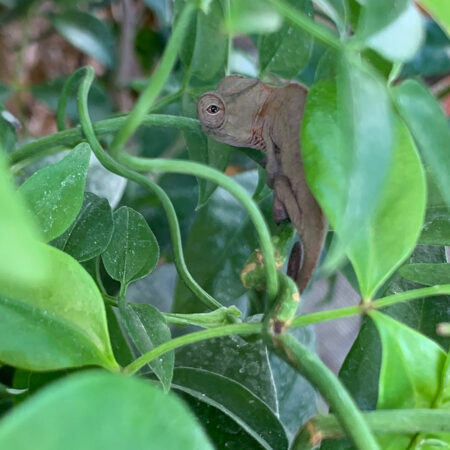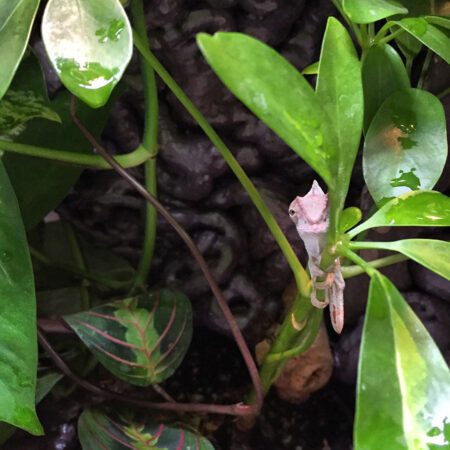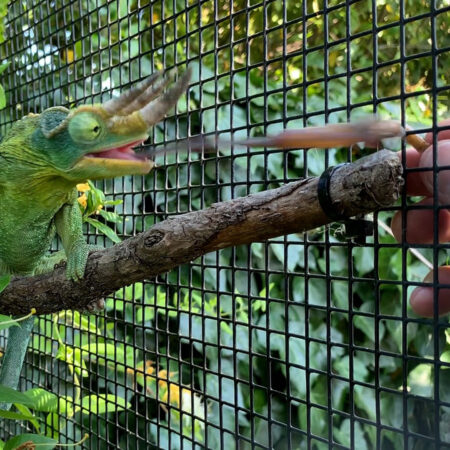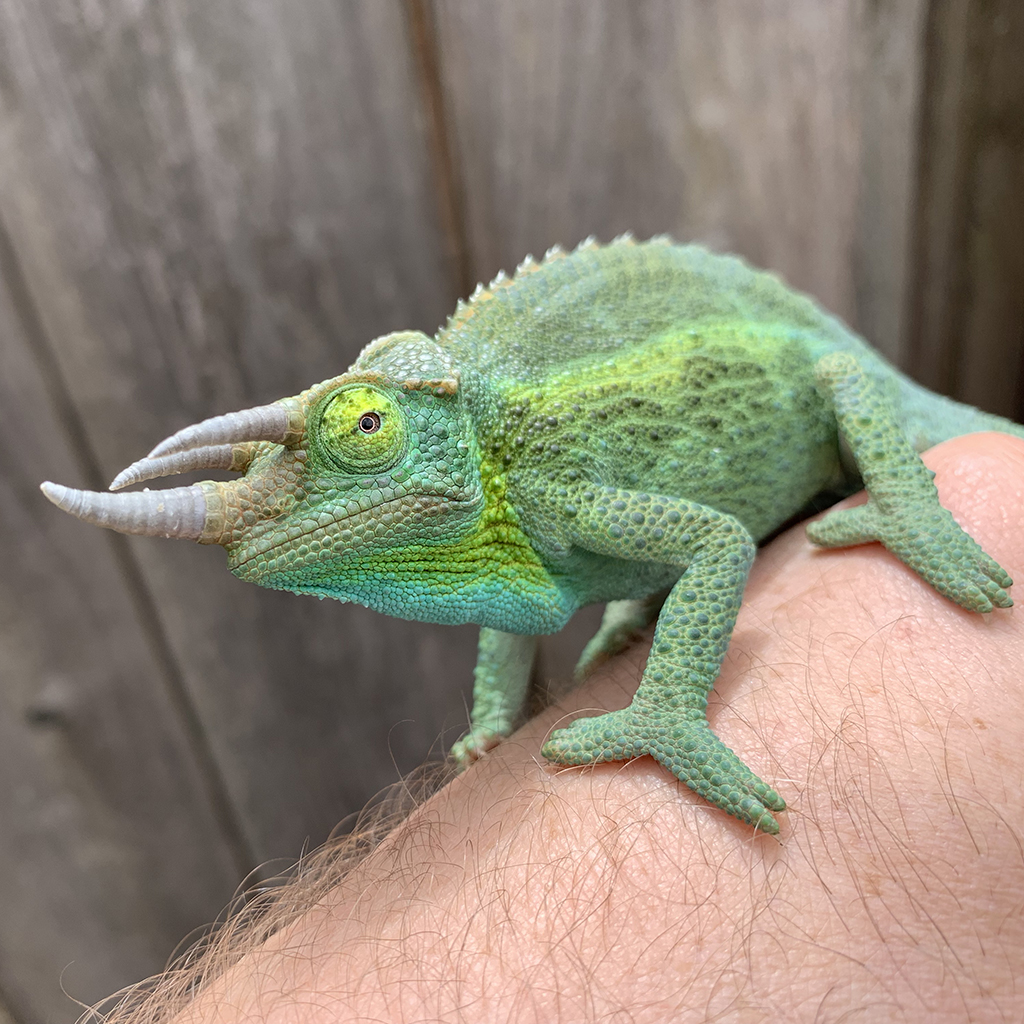A sense of security is critical for your chameleon’s well being. To accurately provide them with safety, we must put aside our human way of looking at the world and see things through their eyes. Chameleon’s can die from stress. So, paying attention to their emotional health is paramount.
You can listen to this page on the Chameleon Academy Podcast through any podcasting app, the dedicated Chameleon Academy iPhone/Android app, or by using the player below to play the episode.
A Chameleon's Sense of Security

We absolutely love our pet chameleons and want the best for them. We scour the care sheets and figure out the best husbandry we can give our little dude. But one critical component that almost never shows up is providing a sense of security.
The luxury of lounging around without worry of being eaten is usually reserved for the apex predator. Chameleons are not that. They are predator and prey. And keeping hidden is a major part of their life for both protection and being able to get food. They were not built with the capacity for speed, armor for defense, or weapons that are much good against the hawk’s claws. So they value, above all else, not being seen.
As the ones responsible for setting up the place where they will live it falls to us to make sure we give them this sense of security. It is all about learning what the world looks like through chameleon eyes. As much as it may hurt our feelings we need to understand that we look suspiciously like a dangerous predator. Bigger than them? check. Mouth able to chomp chameleon? Check. So there is something at their primordial core screaming that being in close proximity to you is not a good thing. You see, being a pet is not something that natural selection has allowed to take hold. Sure, every clutch of chameleons that hatches produces individuals that have a range of fear responses to larger animals. But, I am sorry to say, that the ones that saw larger animals as benevolent masters were removed from the gene pool pretty quickly. The ones that avoided contact with larger animals got to pass on their genes. Chameleons don’t even have a family structure where we can piggy back on some sort of imprinting. Dogs are easy. Not only have they been bred to love humans, but they started off as pack animals just like we are. So dogs already came with an innate sense of family. We just had less hair. So, do you see how there was a strong relationship building capacity already there? Chameleons, on the other hand, never knew their parents and only a handful of livebearers have a chance to have any sort of concept that small chameleons have any connection to large chameleons. There is no caring of the eggs and there is no family structure waiting for them when they hatch. Just a lot of other baby chameleons that their instinct says to get away from. The only other cooperative interaction with another chameleon is in mating and there is no bonding that happens. The closest they come to sticking together is what is called mate guarding where the male will stick around to make sure no other male mates with the female. Just to be clear, this has nothing to do with our version of romantic love. So, there is no role in the chameleon’s life that we can hijack and be considered just one of the family. I say all this to paint a realistic picture of the situation that we deal with when bringing a chameleon into our lives. We do not have the option to convince chameleons that we are family. We only have the option to adjust how much of a threat or how benign we are.
Now, it isn’t as bad as it could be. Chameleons are intelligent enough to be able to change how they see us. They can tell the difference between humans and can build a trust with humans that earn it. So all of my throwing cold water on the chances for a relationship between your chameleon and you was not to say that there isn’t anything there, but to get us to understand the mindset of our chameleon and be realistic as to what is possible. The aspect that is relevant to today’s topic is to encourage an awareness of how important it is to create a foundation of security when setting up the home for your new chameleon. Your chameleon will, most likely, settle into a properly set-up cage and get used to your presence. They may even grow to anticipate your arrival because of what that means. But all of this and everything that is possible to be built between you and your chameleon all starts with your chameleon having a sense of security. It is hard doing anything else when your insides are screaming that you are vulnerable. So, what say we dive in here and take a look at what gives chameleons a sense of security.
Components of Chameleon Security: Dense Plant Cover

Chameleons look at the world much differently than we do and so we can’t go by our feelings to judge their mindset. As we talked about before, chameleons aren’t fast and don’t have much to defend themselves with. So their main defense is not being seen. This is why I keep talking about a densely planted cage. A thicket of leaves allows the chameleon to feel safely hidden. This is especially important when they are sleeping. In the wild they will often find long thin branches to sleep on so they can be alerted if a snake tries to crawl out to get them. We can’t give them long thin branches out into free space with the usual cage sizes available, but we can put a network of perching branches behind a wall of foliage which will provide the security they desire.
For us to give them this security we must create the cage in a way that has the foliage up where the chameleons can use it. Usually my cages have 9-12” from the top of the cage open with basking branches and then 2 to 2.5 feet of dense leafy area and then what is left on the bottom to have a clear floor so we can observe health through the poop. This design has proven highly effective in chameleon husbandry. Now, getting foliage in the middle is often a challenge. This is precisely why I invented the Dragon Ledges which are anchors that attach to screen cages and allow you to mount branches and potted plants right where chameleons need them without stressing the screen. Of course, when using hybrid cages with PVC sides you can easily mount things to the sides. Don’t worry about drilling holes. Make it yours. Customize that thing. Glass cages can get support for plants higher up by using cork bark, thick branch, or some other item anchored down and running the height of the cage. No matter how you do it, ensure that it is solid and secure. It is common in the community for people to attach things to the screen, but this is not solid and secure. Whatever DIY solution you wish to employ, make sure the weight of the branches or potted plants is being supported by the frame, not the screen. You use your own judgement, but the important thing is that there is dense plant cover where the chameleon can use it.
I do want to make a special mention of how plants on the floor are not useful for this purpose. You have a chameleon that likes to hide up in trees. He will not be going down to the floor to comfortably perch in the plant cover down there.
Components of Security: Height

Chameleons also derive a sense of security by being above it all. You will be surprised at how your chameleon calms down when they look down on you. How many of you right now have your cages on the floor? There will be an immediate change in their behavior when you lift that cage and set it on a stand or dresser. Get their top perching branch just a little higher than head level and your chameleon could very well take on a whole new personality. If your chameleon is highly defensive towards you in their cage just try this. Set their cage up so they look down on you instead of looking up at you. And there is no magic. You have a tree dwelling animal. This is what they were designed for. All this insight is, is looking at the world through the eyes of your chameleon and understanding the life they live.
Components of Security: Surprise

One thing chameleons hate is surprise. So another component to security is to make sure their cage is not placed where they can’t see you coming. If you have a hybrid cage which has opaque sides, have the cage face the door so your chameleon can see you coming a long ways off. Don’t put their cage next to the kitchen door which will open frequently at random times. Every house will have a unique set-up so you have to understand the concept and apply it for your unique situation. Make sure that no one can inadvertently sneak up on your chameleon and surprise it. This fills your chameleon with fight or flight hormones when they see you. And that is opposite from what we want! We want them familiar and comfortable with us in the same room or even in their cage. And so we need to be constantly aware of everything we do around them. Our actions either confirm that they should be scared of us or they present a new way to view this particular animal that is larger than themselves. Everything, intentional or unintentional, adds to their perception of us and we need to be deliberate in stacking the points in the favor of them being comfortable or even excited to see us.
Components of Security: Potential Predators
And we can’t have a section on security without talking about other pets. Social media is filled with people introducing their chameleons to their dogs that, of course, would never hurt a fly. That is, until they do, and even if they don’t, your chameleon is aware that they are now close to a predator. Don’t introduce them to the other animals in the family and be acutely aware of any interaction and how that affects your chameleon. Cats sleeping on the cage, dogs sniffing the door, birds just sitting over in the corner of the room. Hawks circling through the window outside…all of these are stress points for your chameleon. The name of the game here is to reduce stress points.
Special Consideration for Chameleon Babies

Since the best way to start with chameleons is to get a juvenile chameleon it is worth recognizing that a juvenile chameleon will be naturally more skittish than adults. As juveniles, they are hyper-aware of being a tasty morsel so being much more suspicious and flighty serves them well. Just know that a juvenile chameleon will be in even more need of their sense of security to grow up strong.
And this is a strong argument for using an adult size cage for your juvenile. A smaller chameleon absolutely does not need a smaller cage. We generally do this because we are not confident in their ability to survive in a 2x2x4 cage. I can tell you they not only do just fine in an adult size cage, I can tell you they do better in a large cage. Because the larger the space the more areas you can create that are hidden giving your juvenile multiple places to feel safe in. You can’t do that in a smaller cage. And, by the way, starting your juvenile off in the adult cage has the advantage that smaller plants can still provide them enough to hide behind and, if you take care of the plants well, the plants will grow with your chameleon and you may have much more foliage in the cage by time you have an adult chameleon. Consider this if you have trouble finding house plants the size you need.
Familiarity Training

You know I take a conservative view when it comes to interacting with my chameleons. I frown at most handling (although occasionally done it is no problem) but it is important that our chameleons are comfortable with us. They now live in our homes and we can’t have them stressing out whenever they see us. Luckily, chameleons are pretty smart and they can learn that we mean no harm. The relationship can grow to the point where they are actually excited to see us because of the food they know we are bringing. So, if we respect what a chameleon is and we go slow there is no reason why we can’t remove ourselves from the list of things that they feel threatened by.
I don’t want to call this taming because that has connotations of handling. I am not opposed to taming done carefully, but for a basic discussion on a chameleon’s sense of security I’d like to call this familiarity training. This is where they get used to you being in the same room as they are and even milling about in their cage. The goal of this is simple. For your chameleon to not feel threatened by you. It is a success if they only feel annoyed by you. We are not looking for them to come running out to greet you. We are looking for them to not consider you a danger even when you are in their cage. That is the goal of basic familiarity training.
And the benefits are great. They will have no problem with you sitting there working at your desk and when it is time to go to the vet they are very put out, but they are not panicking. Although we handle our chameleons as little as possible we also want them to be able to have a visual inspection on our hand without a lot of stress. The reason why this is a discussion topic in an episode dedicated to a chameleon’s sense of security is because we are a constant component to their life. We need to remove the feeling of being threatened from being attached to us.
Chameleon Comfort with Seeing You

First of all, we need to work with the situation of the chameleon just seeing us. How many of you have a chameleon that swivels around their branch every time you walk by? This is very common in young chameleons as mentioned before. This is your chameleon reacting to a threat level and we want that to lessen. Luckily, they tend to mellow with age so don’t be too discouraged. Often, once they get full grown, they come into their own and develop a self-confidence. And once they have that, they react less threatened by you. But, if we do some basic steps all along the way we can make that transition more complete. So, you can start familiarity training right away and start with visual comfort first.
This first part is very simple. Make sure you have followed what we talked about and set up their cage with ample hiding places, placed the cage high up, and made sure there were no surprises to keep them, constantly off balance. Then you just spend a couple months having quiet activities in eye shot of the cage. You are developing a familiarity with your presence. Chameleons can tell the difference between people so they are getting to know you. Move slowly. Be predictable. You are being studied. They are comparing you to all the evil their instincts say you are. You need to act in a way that confirms nothing natural selection accuses you of, but, instead, gives positive examples of why your chameleon should think differently about you.
It may seem like you are doing nothing, but nothing bad happening day after day, week after week, is exactly what they need, to learn you are not dangerous.
Chameleon Comfort with Your Hand

The second step is to get your chameleon comfortable with your hand invading its cage safe space. Now since we have to clean the cage every couple days with at least spot cleaning, we are doing this second step in parallel with the first. But this one is one we will take slow. If your cage has a flip up utility door at the bottom to allow you to access the floor without opening the main doors then use that to clean the cage floor. Your invading hand will be well below your chameleon in his safe leafy home. Move slow and do not try and interact with your chameleon.
Start off with just getting them comfortable with your hand in their cage doing basic clean up.
The hand goes in, moves very slowly, and ignores them. I know this is boring, but this is important. You are not forcing interaction. Your goal, at this point, is to establish a comfort level with your hand being near them. That it doesn’t mean danger. Do this exercise before feeding each day so they associate your disruption to their life meaning they get food. You want your hand in their cage to be a mundane experience. Over the weeks you should be able to, moving slowly, get closer and closer to them without them panicking. The important thing is that they are always free to run away, they never feel trapped, and you do not force anything on them like forcing them to sit on your hand. Sitting on your hand may come later, but that shouldn’t be a priority. The priority should be your chameleon’s sense of security which will pay back dividends in the form of a healthy life.
And then leave him with his feeder run cup so that he knows that when your hand comes into his realm that there are good things left. And do this on a regular basis.
The fact is that some chameleons will crawl out on your hand the first day without a care in the world while other chameleons will be afraid of your hand still a year later. I wish there was a reliable way to tame chameleons, but there just isn’t.
Replacing fear with excitement

In each one of these steps we start with a handicap. Chameleon instinct pegs us as dangerous. And we not only have to dig out of that hole, but then build a positive relationship. As we do this, we need to keep in mind that everything we do either confirms that they should be afraid or it eases the stress we cause. Judge every interaction like that. Ask if it will increase the trust or solidify what their instincts tells them they should be feeling. It is ten times harder to replace the instinct than it is to confirm the instinct. Hopefully, that helps you remember to be very patient and move forward with baby steps.
You may ask, what is damaging to the relationship? Anything where you are forcing them to do something. Examples- Forcing them to sit on our hand is damaging. Catching them in our hand is damaging.
So it is time for us to get creative in figuring out what will replace the instinct?
Giving them tasty treats is helpful and moving slowly goes against what a predator would do. It seems the odds are stacked against us because there is so much we can do that will damage the relationship and only a couple things that help the relationship. But those are the cards we are dealt. That is why things move slowly.
There is the unfortunate case of when the chameleon has to get medication whether oral or injected, medicating a chameleon requires them to be immobilized for a brief second. During this brief second we are lucky if they gape at us and allow the medicine to be shot inside their mouth. But it could be as bad as having to force their mouth open or sticking them with a needle. Honestly, just going through a medication routine has destroyed relationships. Chameleons do not understand medicine and they do not connect their trauma in getting the medicine with the feeling better which comes long afterwards. I am sorry to say that, while many chameleons brush this off, some chameleons remember for life. But there is no other choice. You are giving them medicine to save their life so it is just something that needs to be gone through. Have your vet show you how to administer the medicine and, if possible, give the first dose while your vet supervises. The point is, that the more competent you are at giving medicine the quicker it will be over and the less it will be stressful.
The message today is – be patient. Impatience will bring stress to your chameleon and move you backwards in them accepting you. But that is okay. We are running a marathon here, not a sprint. So there is time to develop a relationship with your chameleon. It won’t be like a dog or human relationship. It will be one that is unique to you and your chameleon. If you go in open to what can be and ultra-sensitive to your chameleon’s sense of security then you will be creating a most unlikely relationship between human and mini-tree dragon.
Conclusion
Developing a relationship with an animal that was never designed to have relationships is a tall order. Lucky for us, there is, at least, some intelligence which we can appeal to in order to see if we can be an exception. The main think to keep in mind when working with a chameleon is to be patient. I have said it over and over and I imagine I will continue saying this because that is the key. That, and accepting whatever capability or limitations your chameleon has as something that is just part of your pet and something to be accepted and embraced (not literally!)
Appendix
Part of the outreach on a chameleon’s sense of security was a daily short thought video. I am including them here for easy reference if you would like to see them.
Navigation
This seminar is part of the introductory course Chameleon Basics which, in turn, is a module within the even larger Term 1: Getting Started With Chameleons.
This seminar is the last in the Chameleon Basics course. The next course in Term 1 is Choosing Your Chameleon!





